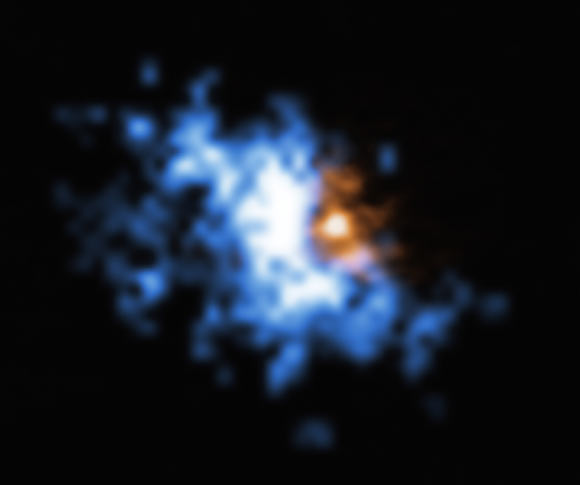VLT Spots Huge Halos of Cool Hydrogen around Active Galaxies in Early Universe | Astronomy – Sci-News.com
Astronomers using ESO’s Very Large Telescope (VLT) have spotted enormous hydrogen halos around 12 quasars — a type of active galaxy which shines brightly because of jets from a supermassive black hole at its center — in the early Universe. These gas reservoirs are the perfect ‘food’ for supermassive black holes in the quasars, which are located over 12.5 billion light-years from Earth.

This illustration depicts a gas halo surrounding a quasar in the early Universe. The quasar, in orange, has two powerful jets and a supermassive black hole at its center, which is surrounded by a dusty disk. The halo of glowing hydrogen is represented in blue. Image credit: M. Kornmesser / ESO.
The recent discovery of quasars a few hundred million years after the Big Bang represents a major challenge to astronomers’ understanding of supermassive black holes as well as formation and evolution of galaxies.
The extreme brightness of quasars is produced by gas accretion onto black holes. Simultaneously, their parent galaxies form hundreds of stars per year, using up gas in the process.
“The presence of these early monsters, with masses several billion times the mass of our Sun, is a big mystery,” said Dr. Emanuele Paolo Farina from the Max Planck Institute for Astronomy.
“It means that the first black holes, which might have formed from the collapse of the first stars, must have grown very fast. But, until now, astronomers had not spotted ‘black hole food’ in large enough quantities to explain this rapid growth.”
To solve this mystery, Dr. Farina and colleagues analyzed data for 31 distant quasars from the MUSE (Multi Unit Spectroscopic Explorer) instrument on the VLT telescope.
The astronomers found that 12 quasars from their sample were surrounded by huge halos of cool, dense hydrogen gas extending 100,000 light-years from the central supermassive black holes and with billions of times the mass of the Sun.
They discovered these hydrogen halos by their characteristic glow in the UV light.

This image shows one of the gas halos observed with the MUSE instrument on VLT superimposed to an older image of a galaxy merger obtained with ALMA. The large-scale halo of hydrogen gas is shown in blue, while the ALMA data is shown in orange. Image credit: ESO / Farina et al / ALMA / NAOJ / NRAO / Decarli et al.
“The most likely explanation for the shining gas is the mechanism of fluorescence. The hydrogen converts the energy-rich radiation of the quasar into light with a specific wavelength, which is noticeable by a glimmer,” Dr. Farina said.
The team also found that these halos were tightly bound to the host galaxies, providing the perfect food source to sustain both the growth of supermassive black holes and rapid star formation.
“We are now able to demonstrate, for the first time, that primordial galaxies do have enough food in their environments to sustain both the growth of supermassive black holes and vigorous star formation,” Dr. Farina said.
“This adds a fundamental piece to the puzzle that astronomers are building to picture how cosmic structures formed more than 12 billion years ago.”
“With the current studies, we are only just beginning to investigate how the first supermassive black holes were able to develop so rapidly,” said Dr. Alyssa Drake, also from the Max Planck Institute for Astronomy.
“But new instruments like MUSE and the future James Webb Space Telescope are helping us to solve these exciting puzzles.”
A paper on the findings was published in the Astrophysical Journal.
_____
Emanuele Paolo Farina et al. 2019. The REQUIEM Survey. I. A Search for Extended Lyα Nebular Emission around 31 z > 5.7 Quasars. ApJ 887, 196; doi: 10.3847/1538-4357/ab5847





